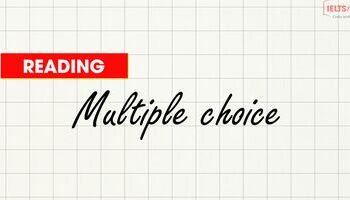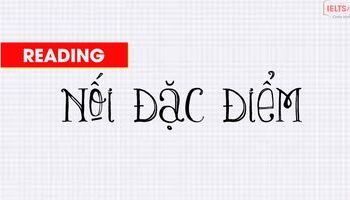I. REVIEW
Chào mọi người, hôm nay chúng ta cùng nhau review lại chiến thuật làm bài kết hợp giải mẫu một bài đọc với dạng bài tập Completing Tables nhé.
Khi làm bài tập dạng này, các bạn chú ý:
- Số lượng từ được cho phép điền vào một vị trí
- Dự đoán trước loại từ có thể điền vào vị trí cần (Noun/Verb/Adj/Adv)
- Từ cần điền sẽ đi gần những keywords nào. Tìm synonyms hoặc paraphrases của những keywords đó
- Check lại đáp án
II. MINI PASSAGE
An important project, led by the biological anthropologist Robert Williams, focused on the variants (called Gm all types) of one particular protein - immunologic G - found in the fluid portion of human blood. All proteins 'drift', or produce variants, over the generations, and members of an interbreeding human population will share a set of such variants. Thus, by comparing the Gm allotypes of two different populations (e.g. two Indian tribes), one can establish their genetic distance, which itself can be calibrated to give an indication of the length of time since these populations last interbred.
Williams and his colleagues sampled the blood of over 5,000 American Indians in western North America during a twenty- year period. They found that their Gm allotypes could be divided into two groups, one of which also corresponded to the genetic typing of Central and South American Indians. Other tests showed that the Inuit (or Eskimo) and Aleut3 formed a third group. From this evidence it was deduced that there had been three major waves of migration across the Bering Strait. The first, Paleo - Indian wave more than 15,000 years ago was ancestral to all Central and South American Indians. The second wave, about 14,000-12,000 years ago, brought No-Dene hunters ancestors of the Navajo and Apache (who only migrated south from Canada about 600 or 700 years ago). The third wave perhaps 10,000 or 9,000 years ago saw the migration from North-east Asia of groups ancestral to the modem Eskimo and Aleut.
How far does other research support these conclusions? Geneticist Douglas Wallace has studied mitochondrial DNA4 in blood samples from three widely separated Native American groups: Pima- Papago Indians in Arizona, Maya Indians on the Yucatan peninsula, Mexico, and Ticuna Indians in the Upper Amazon region of Brazil. As would have been predicted by Robert Williams's work, all three groups appear to be descended from the same ancestral (Paleo-Indian) population.
There are two other kinds of research that have thrown some light on the origins of the Native American population; they involve the study of teeth and of languages. The biological anthropologist Christy Turner is on expert in the analysis of changing physical characteristics in human teeth. He argues that tooth crowns and roots5 have a high genetic component, minimally affected by environmental and other factors. Studies carried out by Turner of many thousands of New and Old World specimens, both ancient and modern, suggest 'hot the majority of prehistoric Americans are linked to Northern Asian populations by crown and root traits such as incisor6 shoveling (a scooping out on one or both surfaces of the tooth), single-rooted upper first premolars6 and triple-rooted lower first molars6.
1. New World: the American continent, as opposed to the so-called Old World of Europe, Asia and Africa
2. Modern Native America: an American descended from the groups that were native to America
3. Inuit and Aleut: two of the ethnic groups native to the northern region of North America (i.e. northern Canada and Greenland)
4. DNA: the substance in which genetic information is stored
5. Crown/ Root: Parts of the tooth
6. incisor/premolar/molar: kinds of teeth
Questions 22-25
The passage refers to the three-wave theory of early migration to the Americas. It also suggests in which of these three waves the ancestors of various groups of modern native Americans first reached the continent.
Classify the groups named in the table below as originating from
A the first wave
B the second wave
C the third wave
Write the correct letter. A. B or C. in boxes 22-25 on your answer sheet.
| Name of Group | Wave Number |
| Inuit | 22 ..................... |
| Apache | 23 ..................... |
| Pima-Papago | 24 .................... |
| Ticuna | 25 ..................... |
III. DISCUSSION
Các em đã chọn đáp án nào và suy luận ra sao nhỉ? Chúng ta cùng nhau thảo luận nhé
Chọn đáp án A/B/C cho phù hợp với cột bên trái
(1) Dùng từ khóa là “Inuit” và “wave”
-->> Other tests showed that the Inuit (or Eskimo) and Aleut3 formed a third group.
-->> The third wave perhaps 10,000 or 9,000 years ago saw the migration from North-east Asia of groups ancestral to the modem Eskimo and Aleut.
-->> Đáp án: C
(2) Dùng từ khóa “Apache”
-->> The second wave, about 14,000-12,000 years ago, brought No-Dene hunters ancestors of the Navajo and Apache
-->> Đáp án: B
(3) Dùng từ khóa “Pima-Papago”
-->> How far does other research support these conclusions? Geneticist Douglas Wallace has studied mitochondrial DNA4 in blood samples from three widely separated Native American groups: Pima- Papago Indians in Arizona, Maya Indians on the Yucatan peninsula, Mexico, and Ticuna Indians in the Upper Amazon region of Brazil.
-->> Địa danh này thuộc the first wave
-->> Đáp án: A
(4) Dùng từ khóa “Ticuna”
-->> How far does other research support these conclusions? Geneticist Douglas Wallace has studied mitochondrial DNA4 in blood samples from three widely separated Native American groups: Pima- Papago Indians in Arizona, Maya Indians on the Yucatan peninsula, Mexico, and Ticuna Indians in the Upper Amazon region of Brazil.
-->> Địa danh này thuộc the first wave
-->> Đáp án A
Bài tập này không hề khó nếu chúng ta có chiến thuật làm bài rõ ràng và kỹ năng scan tốt đúng không các bạn. Các bạn hãy thử sức với những bài tập Reading- Completing Tables khác đến từ IELTS- Fighter nhé <3
Chúc bạn học tốt <3





